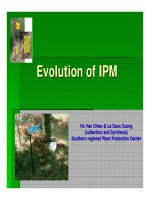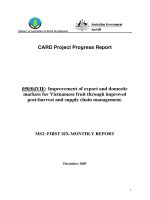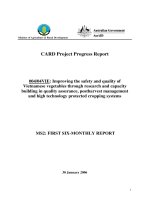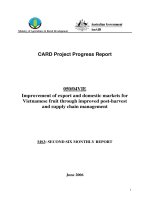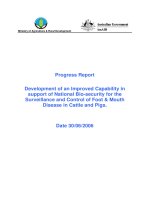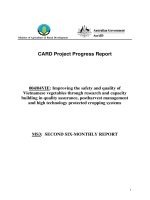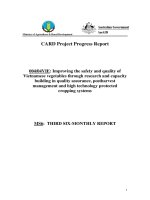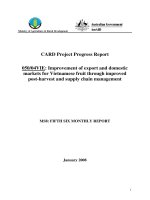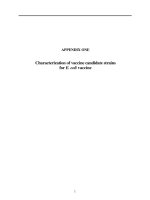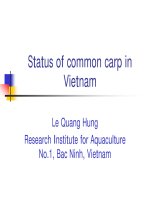Báo cáo nghiên cứu khoa học " Improvement of export and domestic markets for Vietnamese fruit through improved post-harvest and supply chain management - Milestone Report 10 " doc
Bạn đang xem bản rút gọn của tài liệu. Xem và tải ngay bản đầy đủ của tài liệu tại đây (1.92 MB, 90 trang )
1
Ministry of Agriculture & Rural Development
CARD Project 050/04VIE
Improvement of export and domestic
markets for Vietnamese fruit through
improved post-harvest and supply chain
management
Milestone Report 10: SOFRI Capacity Development
Date June 2009
1
Table of Contents
1 Institute Information 3
2 Contact Officer(s) 4
3 Project Abstract 5
4 Executive Summary 5
4.1 Introduction & Background 8
4.2 Implementation Highlights 9
4.3 Southern Sub-Institution of Agricultural Engineering and Postharvest Technology (SIAEP) 10
4.4 Southern Fruit Research Institute (SOFRI) 12
4.5 Post CARD Project Implementation and capacity building for SIAEP and SOFRI 13
5 Mango Groups 44
5.1 Cat Hoa Loc Farmers Group (Co-operative) 44
5.1.1 Brief history of the Cat Hoa Loc Co-operative 44
5.1.2 Cat Hoa Loc Co-operative Mission 44
5.2 Cam Thanh Farmer Group 44
5.2.1 Brief history of the Cam Thanh Farmer Group 44
5.2.2 Cam Thanh Farmer Group Mission 44
5.3 Viet Hung Company (Private Company) 45
5.3.1 Brief History of the Viet Hung Company 45
6 Pomelo Groups 45
6.1 My Hoa Farmers Group 45
6.1.1 Brief history of the My Hoa Farmer Group 45
6.2 Hoang Gia Pomelo Company 45
6.2.1 Brief history of the Hoan Gia Pomelo Group 45
7 Practices before CARD project implementation 46
7.1.1 Supply/value chian analysis, strategic planning methodology and quality control 46
7.2 Pre-harvest Aspects Identified 46
7.2.1 Orchard design for mango and pomelo 46
7.2.2 Canopy management for pomelo and mango 47
7.2.3 Pest and disease control for mango and pomelo 47
7.3 Harvesting practices for mango 49
7.3.1 Maturity indicators for mango 49
8 Postharvest Aspects for pomelo and mango 49
8.1 Fruit grading and sorting for pomelo 49
8.1.1 Fruit grading and sorting for mango 50
9 Practices after CARD project implementation 52
9.1.1 Top 5 Priority for the Mango Strategic Plan are: 52
9.1.2 Top 5 Priority for the Pomelo Strategic Plan are: 52
9.1.3 Pre-harvest capacity building of mango and pomelo farmers 53
9.1.4 Postharvest capacity building for mango and pomelo farmers 62
9.1.5 Supply/value chain capacity building for mango and pomelo farmres 70
10 Examples of farmer groups and capacity built by CARD projects and benefits obtained 77
10.1 Mango 77
2
10.2 Pomelo 80
11 Environment issues 82
12 Conclusions 83
12.1 At the Grower/Farmer level: 83
12.2 At the collector, trader and wholesaler level: 84
12.3 Options 84
12.4 Sustainability 85
13 Appendix 1 86
3
1 Institute Information
Project Name Improvement of export and domestic
markets for Vietnamese fruit through
improved post-harvest and supply chain
management.
Vietnamese Institution Southern Sub-Institute of Agricultural
Engineering and Post-Harvest Technology
(SIAEP)
Vietnamese Project Team Leader Mr Nguyen Duy Duc, M. Eng.
Australian Organisation Queensland Department of Primary
Industries and Fisheries (DPI & F)
Australian Personnel Mr. Robert Nissen
Dr. Peter Hofman
Mr Brett Tucker
Mr. Roland Holmes
Date commenced September 2006
Completion date (original) May 2008
Completion date (revised) December 2008
Reporting period Milestone Report 7
4
2 Contact Officer(s)
In Australia: Team Leader
Name: Mr. Robert Nissen Telephone: +61 07 54449631
Position: Project Leader Fax: +61 07 54412235
Organisation Queensland Department of
Primary Industries and Fisheries
(DPI & F)
Email:
In Australia: Administrative contact
Name: Michelle Robbins Telephone: +61 07 3346 2711
Position: Senior Planning Officer
(Emerging Technologies)
Fax: +61 07 3346 2727
Organisation Queensland Department of
Primary Industries and
Fisheries (DPI & F)
Email:
In Vietnam
Name: Mr Nguyen Duy Duc, Telephone: +84 (8) 8481151
Position: Director SIAEP Fax: +84 (8) 8438842
Organisation Southern Sub-Institute of Agricultural
Engineering and Post-Harvest
Technology (SIAEP)
Email:
5
3 Project Abstract
4 Executive Summary
Having a good understanding of what constitutes a supply/value chain is critical to it understanding
how they operate, how to analyse the chain and how to make changes to the chain to benefit all
the chain members.
Many individual companies adopt and adapt what they consider are key elements or building
blocks of a supply/value chain. They put these building blocks together to suit their particular
needs without considering all the necessary supply/value chain elements to be successful.
Supply/value chain participants today must be highly adaptable, as inflexible participants will not
generate added value and will be forced out of their industry. These participants must adopt new
supply/value chain strategies that will deliver value for money to their customers and ultimately, the
end consumer.
Before the commencement of the CARD Project, SIAEP staff skills were confined to postharvest
aspects. They had some knowledge of pre-harvest practices, e.g. crop physiology, agronomy and
cultural methodology. Some of the SOFRI staff in the postharvest section were reasonably
knowledgeable of the postharvest aspects of mango and pomelo fruit and methods to maintain
shelf-life in Vietnam under Vietnamese conditions.
Traditional farming practices based on planting seedling mango trees with no canopy management
is significantly affecting productivity, control of pests and diseases, fruit quality and shelf-life of
mango fruit. The types, effectiveness and usage of chemicals in the Mekong Delta of Vietnam is of
major concern.
The fruit industry in Vietnam has a great potential and plays an important role in agricultural
production. In 2003, Vietnam exported US$43 million of high value fruit to high-income countries
and imported US$14 million of fruit and vegetables. Vietnam is experiencing difficulties in
competing with other Asian nations in export markets and its own domestic market, especially with
China and Thailand. This suggests that Vietnam’s horticultural industries require substantial
development to be globally competitive. Vietnamese consumers are demanding safer and higher
quality fruit. This project has identified key pre-and post-harvest technology gaps that reduce
product quality, safety and consistency. Targeted training programs are focusing on the total
supply chain and are providing benefits by helping to implement quality management systems and
GAP systems at the village level providing greater employment for the farming community. This
project embraces the five CARD strategies for rural development; and in particular; strategies to
increase production and competitiveness of agricultural systems; reduce poverty and vulnerability,
and increase stakeholder participation whilst ensuring sustainability.
6
Traditional harvesting practices based on no standardised maturity indicators, process to
eliminated fruit damage, handling, packaging and transportation and the lack of postharvest
practices and development of effective, efficient value/supply chains is seriously affecting the
development of the domestic and export markets for Vietnam.
To build knowledge, SIAEP and SOFRI along with the Australian team developed and produced 5
booklets for Vietnamese farmers as best practice GAP guides. These were:-
• Mango Cultivation Handbook
• Mango Pest Quick Guide Booklet
• Mango Disease Quick Guide Booklet
• Pomelo Cultivation Handbook
• Pomelo Pest and Disease Quick Guide Booklet
By developing these manuals and booklets knowledge for both SIAEP and SOFRI was
substantially increased in the best practice and GAP pre-harvest factors. Also SIAEP and SOFRI
staff knowledge increased in how these pre-harvest factors affect the post-harvest fruit quality,
shelf-life and saleability of mango and pomelo
Participatory action learning training and capacity building in supply/value chains was conducted by
the Australian team for SIAEP and SOFRI. Staff of SIAEP and SOFRI, assisted by the Australian
team members then trained farmers and farmer groups to increase their knowledge of supply
chains and technical processes to maintain fruit quality improve shelf-life and saleability. This
capacity building consisted of 4 phases implemented during this project.
1. Understanding value/supply chains
2. Developing value/supply chains
3. Implementing new value/supply chains
4. Evaluating new value/supply chains
SIAEP and SOFRI have now developed good working relationships with various farmer groups and
private enterprises and these include:-
• Cat Hoa Loc Group
• Metro Cash and Carry
• Thu Duc Wholesale Markets
• COFIDEC Company - Mango processing
• EMU Vietnam (Khanh Hoa Province)
• My Hoa Pomelo Cooperative
• Cat Chu Mango Producers
• Viet Hung Company (Dong Thap Province)
• Can Thanh Mango Company
Two quality assurance manuals were developed as part of this CARD project. They were based
on Vietnamese standards and in consultation with the various farmers groups, collectors and
wholesalers in the mango and pomleo value/supply chains operating in the Mekong Delta of
Vietnam. These manuals were also submitted to CARD Project Management as part of Milestone
9 Reporting.
7
Dr Le Thi Thu Hong from SOFRI presented an oral talk and paper at the International Society of
Horticultural Science (ISHS), Improving the performance of supply-chains in transitional economies
conference held at the Sofitel Plaza Hotel, Hanoi, Vietnam, 13-17 September 2007.
The Cat Hoa Loc mango group have implemented new harvesting and GAP procedures. They
have also built a new pack-house and implemented new handling, postharvest treatments and
quality assurance standards, packaging and logistics systems.
With help from the SIAEP staff and the CARD Project they have:-
• purchased and constructed a cool room
• constructed a ripening room
• constricted drying grading and sorting tables
• developed a specific gravity maturity test
• constructed and are using a washing and hot water heat treatment tanks to
remove contaminates, control fruit fly and diseases on the harvested fruit.
• using fans to dry the fruit on the sorting and grading tables
• packing and grading fruit into fibreboard cartons
• placing the trade mark stickers on each mango fruit in the carton
• implemented quality assurance standards such as:- the pack-house will only
accept extra, first and second grade fruit. Third grade fruit is returned to the
grower and the grower asked not to send any third grade fruit to the pack-
house in the future
In 2008 about 700kg to 1 tonne of Cat Hoa Loc grade 1 fruit were sold to Metro Cash & Carry
Vietnam Ltd., as a trial shipment. This fruit sold from 55,000 to 75,000 VND/kg. This is about
double to triple the normal price. At the end of the CARD Project, a contract was signed with Metro
Cash & Carry to supply 5 tonne of fruit. The group also supplies about 70 tonne of fruit to a
processor who exports to Japan.
The Nam Roi Pomelo My Hoa Farmers Group has obtained Global Gap certificate 2. Tthey
exported 18 twenty foot containers to Holland and received about 10,500 VND / kg. This is double
the local price paid for pomelo. In 2009 this group exported about 70 twenty foot containers (about
1000 tonne) to Holland and Belgium for about 8,700 VND / kg. They have now signed a contract
with Metro Cash and Carry for 34 tonnes of pomelo. They also supply supermarkets in Hanoi with
about 18 tonnes of pomelo. They have been trialing fruit vacuum bagging to reduce moisture loss
and extend the fruit shelf life. They have also trailed citra shine wax. They have implemented
GAP process such as:-
• CV for each orchard
• production procedure for each member
• cultivation procedures
In the pack-house they have also implemented quality assurance processes. Some processes put
in place at the pack-house are:-
• fruit are cleaned by water solution containing chlorine at 150 ppm
• trialing vacuum bagging and drying by fan of pomelo fruit for export to Europe
• trialing the use net bagging of fruit
• placing an origin stamp on fruit
8
• constructed a cool room
4.1 Introduction & Background
Ford et al., (2003) analysed the competitiveness of fruit industries in Vietnam and identified:
• poor unstable product quality
• no quality standards
• poor post harvest technologies
• poor pre-harvest practices
• lack of group co-operative marketing structures
• little information about supply chains, prices and customers needs.
Stakeholder/beneficiary analysis of fruit crops in the Mekong delta showed that both mango and
pomelo (with plantings of 33 000 ha and 9 000 ha, respectively) are very important fruit crops in
Southern Vietnam. The objectives of this CARD project 05/040 VIE are to:
• Improve pre-harvest technologies to produce high quality mango (integrated pest
management, integrated crop management, fruit fly control, maturity indices, reduced
pesticide residues, better environmental and human health etc)
• Improve mango and pomelo post-harvest technologies (eg, cool chain management,
packaging, post-harvest dipping, ethylene ripening, waxing, washing and wetting agents,
quality assurance)
• Improve quality standards and quality assurance programs for mango and pomelo. The
approach and methodologies developed for these crops through this project will be
applied to other fruits and vegetables.
• Map current supply chains to domestic and selected export markets, with particular
emphasis on determining consumer preferences and needs, and reporting results back
to farmers.
• Provide a better understanding and possible improvements of the supply chain by
Vietnamese fruit industries for mango and pomelo.
This CARD project provide capacity building training to reduces major weaknesses in pre- and
post-harvest technologies affecting product quality, consistency of mango and pomelo. This
project has also increased the knowledge and ability of the staff at the Sub-Institute of Engineering
and Postharvest Technology (SIAEP) and Southern Fruit Research Institute (SOFRI) to analyese,
develop and implement new technologies and change practices to supply chains presently
operating in Vietnam. Further training was also provided to farmer groups and chain participants.
Highly specialised targeted participatory action learning (PAL) training programs were developed
and provided to these institutions and industry stakeholders by this CARD Project 050/040 VIE.
CARD Project 050/040 VIE Milestone 10 is:
Assessment and documentation of SOFRI and SIAEP institute staff and the farmer group’s
competence in:-
• Application of supply chain analysis and methodology
• Application quality assurance procedures and processes
9
This report is based on case studies of Institutes SIAEP and SOFRI and farmer mango groups (Cat
Hoa Loc, Cam Thanh and Viet Hung Company) and the pomelo groups (My Hoa and Hoang Gia
Pomelo Company). Information presented in this report highlights the situation before the project
commenced (pre-project) and the project impacts (post-project). This report show how the
capacity of the institutes and farmer groups has been substantially increased. Each case study
also provides evidence of the application of supply chain analysis and methodology and quality
assurance procedures and processes.
4.2 Implementation Highlights
4.2.1.1 Background of supply/value chains
In the past supply chains were analysed using generic logistic processes such as Commodity
Management (CM) as implemented by large supermarkets. This analysis process has now
changed to one of creating value for all participants in the supply chain; therefore supply chains are
now transformed into value chains. A supply/value chain can be described as:
• The planned continuous improvement of processes and relationships that exist to support
the movement of goods and services through the value chain that benefits its customers
and members.
• A value chain is a mutual business agreement between both Horizontal and Vertical
businesses whose combined actions result in the delivery of products to a customer for the
benefit of all involved.
• The value chain of an organisation covers the full range of activities from the earliest level
of input through the internal process in the host organisation and on to the output
distribution system.
Having a good understanding of what constitutes a supply/value chain is critical to it understanding
how they operate, how to analyse the chain and how to make changes to the chain to benefit all
the chain members.
Many individual companies adopt and adapt what they consider are key elements or building
blocks of a supply/value chain. They put these building blocks together to suit their particular
needs without considering all the necessary supply/value chain elements to be successful.
Therefore; supply/value chain participants today must be highly adaptable, so that they can
generate added value. These chain participants must adopt new supply chain strategies that will
deliver will benefits for themselves, create value for money to their customers’ and ultimately, the
end consumer.
Supply/value chain participants today must be highly adaptable, as inflexible participants will not
generate added value and will be forced out of their industry. These participants must adopt new
supply/value chain strategies that will deliver value for money to their customers and ultimately, the
end consumer.
Two quality assurance manuals were developed as part of this CARD project. They were based
on Vietnamese standards and in consultation with the various farmers groups, collectors and
wholesalers in the mango and pomelo value/supply chains operating in the Mekong Delta of
Vietnam.
10
4.3 Southern Sub-Institution of Agricultural Engineering and
Postharvest Technology (SIAEP)
4.3.1.1 History of SIAEP
SIAEP is located in HCMC and is a merger between Post-harvest Technology Institute and the
Agriculture Electro Engineering Applied Centre in 2003. SIAEP is now involved with a range of
supply/value chain projects in the fruit and vegetable industries, with a focus on improved quality
management, management of maximum residue limits (MRL) and food safety issues. They have
used their sound technology base and are extending to combine this technology skill set with
business development skills to be, as a direction of MARD, a more market driven institution. Part
of this market driven approach is to engage more directly with the private sector and develop more
successful public:private partnership (PPP). These PPP have been developed primarily in the fruit
and vegetable wholesale markets of HCMC to support improved quality and food safety
management, but have the capability to be extended through the supply chain to smallholder
producers. Although based in HCMC, SIAEP has been involved in a number of projects that have
been focussed in a number of regional provinces in the Mekong Delta and South Central Coast of
Vietnam.
4.3.1.2 Pre CARD Project Implementation
4.3.1.2.1 P
RE-HARVEST KNOWLEDGE
Before the commencement of the CARD Project, SIAEP staff skills were confined to postharvest
aspects. They had some knowledge of pre-harvest practices, e.g. crop physiology, agronomy and
cultural methodology. Mr Binh was developing good agricultural practice (GAP) processes for
pomelo and mango farmers, but SIAEP staff did not have an understanding how pre-harvest
factors affect the postharvest fruit quality and shelf-life of mango and pomelo. Some staff
members also had the capability of indicating that a fruit was affected a disease or pest but did not
understand the factors contribution to these pests or disease. Areas where important knowledge
was lacking were:-
o Integrated Pest Management (IPM) and Integrated Disease Management (IDM)
concepts and how this can improve fruit quality, fruit shelf-life and saleability, and
reduce types and quality of chemicals applied and on-farm input costs.
o Canopy management (pruning and training). (See Appendix A for these pre-harvest
factors and their affects on postharvest shelf-life, saleability and fruit quality.)
o Orchard management and Orchard design to facilitate the harvesting, handling,
sorting, grading and consolidation (packaging) for transport to markets.
o Fertiliser (organic and in-organic) and irrigation practices to enhance fruit quality, shelf-
life and saleability.
o Flowering and fruit growth aspects and how these factors affect fruit quality, shelf-life
and saleability.
o Elimination of sap burn, abrasion, impact and rub marks of fruit.
4.3.1.2.2 P
OSTHARVEST KNOWLEDGE
Most of the SIAEP staff were reasonably knowledgeable in the physiological aspects and
traditional postharvest aspects mango and pomelo fruit and methods to maintain shelf-life under
Vietnamese conditions. For Example, Mrs Ha researched and developed a maturity index for
11
pomelo based on external characteristics, e.g. oil gland development, skin colour and texture, but
this was developed further into a quality assurance manual for Vietnamese pomelo farmers.
SIAEP staff did have some knowledge of some new postharvest methods developed overseas but
the practical aspects and experience of applying these methods was lacking. Such aspects were:-
o reduction or elimination of sap burn
o excess nitrogen effects or fruit ripening and internal fruit quality
o latest findings on internal fruit breakdown
o new methods of ripening mango fruit (ethylene injection vs. acetylene)
o ripening and storage temperatures
o and storage methods and their affects on fruit quality and shelf life
Other areas where the SIAEP staff lacked good first-hand knowledge was:-
o the development of quality manuals and quality standards
o how to produce quality manuals
o how to engage all members of the supply chain in the development of these manuals
o why packaging is important at the grower - collector level
o product temperature control along the supply chain from grower/collector/wholesaler to the
consumer
o cool room and ripening room design and development
4.3.1.2.3 S
UPPLY/VALUE CHAIN KNOWLEDGE
Some of SIAEP staff had little knowledge of what supply chains or value chains were, but they
lacked detailed knowledge on how to:-
• understand the complexities and analysis existing supply/value chains
o understanding what customers and consumers want and development of effective
and efficient logistic and distribution systems
o develop information sharing and communication channels
• assist chain members to improve their products and chain participation to achieve more
profitable outcomes
o how to create product value and share with other chain members the value
created
o how to get the product right for the consumer
o how to work with chain participants (groups of growers, wholesalers, retailers etc.,)
working with farmer groups to achieve the desired outcomes such as lead growers
implementing new techniques or
• develop or build new supply/value chains.
Having these skills is now critical for many public and private institutes/companies in Vietnam. This
is due to:-
• Adherence to the WTO rules of trade between nations and The Codex Alimentarius
Commission. This Commission was created in 1963 by FAO and WHO to develop food
standards, guidelines and texts on codes of practice under the Joint FAO/WHO Food
Standards Programme. The purpose of this programme is to protect the health of the
consumers and ensuring fair trade practices in the food trade, and promoting of all food
standards governmental and non-governmental organizations.
• Development of the Vietnamese VIET GAP standards.
• Development of new agribusiness supply/value chains to satisfy both domestic and export
agricultural markets.
12
• An increase in supermarkets in Vietnam (domestic and foreign owned) and their food
quality assurance programs to supply their customers with products that meet Vietnams
GAP and health standards.
• Vietnam is experiencing difficulties in competing with other Asian nations in export markets
and its own domestic market, especially with China and Thailand. This suggests that
Vietnam’s horticultural industries require substantial development to be globally
competitive.
• Vietnamese consumers are demanding safer and higher quality fruit.
4.4 Southern Fruit Research Institute (SOFRI)
4.4.1.1 History of SOFRI
Originally called the Long Dinh Fruit Research Center (LDFRC), was founded on 26 March 1994 by
the Ministry of Agriculture and Rural Development. LDFRC was then upgraded to be the Southern
Fruit Research Institute (SOFRI) under the Decision No. 1056/1997/QD TTg on 9
th
December
1997. SOFRI is located along the roadside of the national highway running towards the Mekong
Delta at Long Dinh Commune, Chau Thanh District, in the province of Tien Giang. SOFRI is about
75 km to the West of Ho Chi Minh City in Southern Vietnam and is 67.5 ha in size. SOFRI is
affiliated with the South Eastern Fruit Research Centre located on 476 ha of land located in Baria-
Vungtau Province. SOFRI has a 6 research divisions and 6 administrative divisions and all
working in a multi-disciplinary manner. SOFRI has significant experiencing with international donor
funded projects, including ACIAR and CARD. SOFRI recent involvement in supporting tropical fruit
industries to develop GAP systems and certification with GlobalGAP or VietGAP enables SOFRI to
play an important role in supporting grower groups and supply chains in GAP and accreditation.
The number of staff at SOFRI is 130, with 59 researchers and 18 post graduates (3 PhD, 15 MSc).
4.4.1.2 Pre CARD Project Knowledge
4.4.1.2.1 PRE-HARVEST KNOWLEDGE
Before the commencement of the CARD Project, SOFRI staff skills were good in pre-harvest
aspects. They had good knowledge of pre-harvest practices for mango and pomelo in crop
physiology, agronomy and cultural methodology suited to Vietnamese conditions. For example
Mrs Minh was working on mango agronomic aspects and was developing documents on
manipulating mango flowering and fruit set for the off season. Staff members also had a good
understanding of pathological (disease) and entomological (pests) affecting mango and pomelo.
Staff of SOFRI did not have a high degree of understanding on how these pre-harvest factors
affected the postharvest fruit quality, shelf-life and saleability of mango and pomelo as fruit moved
down the supply/value chain.
4.4.1.2.2 POSTHARVEST KNOWLEDGE
Some of the SOFRI staff in the postharvest section were reasonably knowledgeable of the
postharvest aspects of mango and pomelo fruit and methods to maintain shelf-life in Vietnam under
Vietnamese conditions. For Example, staff of SIEAP (Mr Khanh, Mr Binh and Ms Sam Tram Anh)
carried out some preliminary work on vacuum wrapping of pomelo with poly film and heat treatment
of mango to extend shelf-life. Some work at SIAEP had also been carried out developing
fibreboard packaging but this is expensive in Vietnam compared to traditional bamboo packaging
13
methods. Similarly, staff at SOFRI (Mr Hien and his wife Ms Hong) conducted experiments on
placing pomelo in poly bags and cool storage and heat treatment of mango to extend shelf-life.
Mango heat treatment experiments showed that fruit rots were significantly reduced as well as
increasing the shelf-life. Both SIAEP and SOFRI staff did not have first hand knowledge of new
postharvest methods developed overseas, especially on aspects such as:-
o reduction or elimination of sap burn (through the use of detergents)
o excess nitrogen effects or fruit ripening and internal fruit quality
o latest findings on internal fruit breakdown (stem end rots and internal rots)
o new methods of ripening mango fruit (ethylene injection vs. acetylene)
o ripening and storage temperatures
o and storage methods and their affects on fruit quality and shelf life
Other areas where the SOFRI staff lacked good first-hand knowledge was:-
o the development of quality manuals and quality standards
o and how to produce quality manuals
o how to engage all members of the supply chain in the development of these manuals
o why packaging is important at the grower - collector level
o product temperature control along the supply chain from grower/collector/wholesaler to the
consumer
o cool and ripening room design and development
4.4.1.2.3 S
UPPLY/VALUE CHAIN KNOWLEDGE
SOFRI staff also has little knowledge of what supply chains or value chains were. They also
lacked detailed knowledge on how to:-
• understand the complexities and analysis existing supply/value chains
o understanding what customers and consumers want and developing an effective
and efficient logistic and distribution systems
o develop information sharing and communication channels
• assist chain members to improve their products and chain participation to achieve more
profitable outcomes
o how to create product value and share value with other chain members
o how to get the product right
o how to work with chain participants (groups of growers, wholesalers, retailers etc.,)
working with farmer groups to achieve the desired outcomes such as lead growers
implementing new techniques or
• develop or build new supply/value chains.
4.5 Post CARD Project Implementation and capacity building for
SIAEP and SOFRI
4.5.1.1 Post CARD project knowledge building
When this CARD Project commenced, both SIAEP and SOFRI and the Australian partners
developed a process and action plans where people with the various skills and expertise within
each institute were given various tasks to complete. They then called upon others staff members
within their institutes to help complete their tasks. For example, Mrs Le Thi Thu
Houng of SOFRI
was in charge of organising SOFRI staff to carry out various tasks, they had to complete the
14
manual on mango cultivation handbook. This farmer GAP mango manual was completed by Mrs.
Tran Nguyen Lien Minh, Mr Vo The Truyen.
4.5.1.2 Pre-harvest knowledge building
Key staff from both SIAEP and SOFRI were identified and then used to deliver training to
Vietnamese farmer grower groups assisted by the Australian trainers. Before training the
Vietnamese farmers, train the trainer sessions were conducted. Development of train the trainer
sessions allowed information to be freely exchanged and training sessions developed for the
Vietnamese farmers, farmer groups, collectors, traders, wholesalers, and retailers. The Australian
team members provided new information outside of the information available in Vietnam. For
example, new technologies for best practice and GAP in Vietnam were combination with the
Australian Best Practice Manual for Mango Growing. The Australian GAP manual was translated
into Vietnamese by the Queensland Department of Primary Industries and Fisheries and provided
to the Vietnamese trainers and institutes. Information from Australia was then combined with the
Vietnamese information and framer manual developed by Mrs Minh from SOFRI as indicated
above. Mrs Minh also delivered the best practice training on mango crop management, irrigation
and fertilising, crop regulation and assisted with orchard design workshops etc., before resigning
and leaving the CARD project to take up a new position. Mr Pham Hoang
Lam was ably assisted
by other SOFRI staff, Mr Vien Nghien Mr Do Minh Hien, Ms Nguyen Thi Ngoc Truc, Mr Le Quoc
Dien and other staff for pests and diseases and development of farmer handouts along with
assistance from Ms Tran Thi Ngoc Diep, Mr Le Minh Hung, Mr Ngo Van Binh, Mr Vu Cong Khanh,
Mr Tran Ngoc Linh, Ms Sam Tram Anh and Mrs Tran Thi Kim Oanh of SIAEP. For example, 5
booklets were developed for Vietnamese farmers as best practice GAP guides and there were:-
• Mango Cultivation Handbook
• Mango Pest Quick Guide Booklet
• Mango Disease Quick Guide Booklet
• Pomelo Cultivation Handbook
• Pomelo Pest and Disease Quick Guide Booklet
By developing these manuals and booklets knowledge for both SIAEP and SOFRI was
substantially increased in the best practice and GAP pre-harvest factors. Also SIAEP and SOFRI
staff knowledge increased in how these pre-harvest factors affect the post-harvest fruit quality,
shelf-life and saleability of mango and pomelo. Both SIAEP and SOFRI staff should now able to
carry out a pre-harvest analysis of a supply/value chain and identify problem areas or factors, e.g.
best practice and GAP for canopy management (pruning and training for light interception),
fertiliser and irrigation, fruit maturity indicators, harvesting and infield handling methods to meet
safety and quality standards for mango and pomelo. This was achieved through train the trainer
methods based on participatory action learning processes and the development of these manuals
and booklets. These manuals were provided to the CARD Project Management Unit in Milestone 7
Report.
Evaluations of all workshops attended by SIAEP and SOFRI staff were undertaken to obtain how
effective the learning process was and capacity building by the prevision of new knowledge. The
Objective, Reflective, Interpretive, and Decisional Evaluation (ORDI) Process was used at the
completion of each workshop and presented below is a summary of averages from all training
workshop conducted.
15
16
Summary of Mango Pre-harvest Training Evaluations
0%
20%
40%
60%
80%
100%
Percentage
Very Good Good Not Suitable
Suitability of training facilities?
0%
20%
40%
60%
80%
100%
Percentage
Too Long Right Length Too Short
Length of training activities?
0%
20%
40%
60%
80%
100%
Percentage
All of it Most of it None
% of new information to you?
0%
20%
40%
60%
80%
100%
Percent age
Very Good
Understanding
Good
Understand
Did Not
Understand
Understand concepts?
17
0%
20%
40%
60%
80%
100%
Percentage
Very Useful Useful Not Useful
Usefulness of manuals/workbooks/materials?
0%
20%
40%
60%
80%
100%
Percentage
Very Useful Useful Not Useful
Information useful to your work?
0%
20%
40%
60%
80%
100%
Percentage
Yes Not Sure No
Would further training improve your
confidence?
0%
20%
40%
60%
80%
100%
Percent age
Very Usef ul Usef ul Not Useful
Use these methods/process in your work?
18
0%
20%
40%
60%
80%
100%
Percent age
Yes Not Sure No
Any cultural barriers to these concepts in
Vietnam?
0%
20%
40%
60%
80%
100%
Percentage
Very Good Good Not Good
Trainers' Knowledge
0%
20%
40%
60%
80%
100%
Percentage
VeryGood Good NotGood
Trainers' presentation
0%
20%
40%
60%
80%
100%
Percentage
Highly
Satisfied
Mos tly
Satisfied
Slightly
Satisfied
Training fulfilled your expectations?
19
Summary of Pomelo Pre-harvest Training Evaluations
0%
20%
40%
60%
80%
100%
Percentage
Very Good Good Not Suitable
Suitability of training facilities?
0%
20%
40%
60%
80%
100%
Percentage
Too Long Right Length Too Short
Length of training activities?
0%
20%
40%
60%
80%
100%
Percentage
All of it Most of it None
% of new information to you?
0%
20%
40%
60%
80%
100%
Percentage
Very Good
Understanding
Good
Understand
Did not
Understand
Understand concepts?
20
0%
20%
40%
60%
80%
100%
Percentage
Very Useful Useful Not Useful
Usefulness of
manuals/workbooks/materials?
0%
20%
40%
60%
80%
100%
Percentage
Very Usef ul Usef ul Not Usef ul
Information useful for you work?
0%
20%
40%
60%
80%
100%
Percent age
Yes Not Sure No
Would further training improve
confidence?
0%
20%
40%
60%
80%
100%
Percentage
Very Useful Usef ul Not Useful
Would you use these methods/processes in
your own work?
21
0%
20%
40%
60%
80%
100%
Percentage
Yes Not Sure No
Any cultural barriers to these concepts in
Vietnam?
0%
20%
40%
60%
80%
100%
Percentage
Very Good Good Not Good
Trainers' knowledge?
0%
20%
40%
60%
80%
100%
Percentage
Very Good Good Not Good
Trainers' presentation?
0%
20%
40%
60%
80%
100%
Percentage
Highly
Satisfied
Mos tly
Satisfied
Slightly
Satisfied
Training fulfilled your expectations?
22
4.5.1.2.1 P
OSTHARVEST KNOWLEDGE
As indicated above in the pre-harvest section key staff from both SIAEP and SOFRI were identified
and then used to deliver training to Vietnamese farmer grower groups assisted by the Australian
trainers. Development of train the trainer sessions, allowed information to be freely exchanged and
training sessions developed for the Vietnamese farmers, farmer groups, collectors, traders,
wholesalers, and retailers. The Australian team members provided new information outside of the
information available in Vietnam. For example, Mr Nissen purchased and imported into Vietnam
the detergent/surfactant used for stopping sap burn on mango. Sap burn on mango allows
diseases, e.g. Anthracnose and Rhizopus rots etc., to quickly infect the fruit make fruit unsalable
with in a few days, especially under Vietnamese supply chain conditions. This detergent was
trailed via a demonstration session in train the trainer session. Effects on fruit quality, storage life
and saleability were assessed and results found the detergent to be highly effective, especially with
Cat Hoa Loc Mango. This was then demonstrated to farmers, farmer groups, wholesalers, traders,
etc., in training workshops conducted in the Mekong Delta and Nha Trang by SIAEP Staff (Ms Tran
Thi Ngoc Diep, Mr Le Minh Hung, Mr Vu Cong Khanh, Ms Sam Tram Anh and Mrs Tran Thi Kim
Oanh). Ms Tran Thi Ngoc Diep, Mr Le Minh Hung, Mr Vu Cong Khanh, Ms Sam Tram Anh and
Mrs Tran Thi Kim Oanh also conducted workshops assisted by the Australian team members on:-
• Harvesting and field handling of mango
• Mango post-harvest and physiology
• Development of mango and pomelo quality assurance guides
Mr Vu Cong Khanh, Ms Sam Tram Anh and Mrs Tran Thi Kim Oanh of SIAEP also conducted
research on mango and pomelo to maintain fruit quality, improve shelf-life and saleability for the
farmer groups involved in this project. These experiments included:-
• The use of vacuum wrapping for pomelo and MAP (Modified Atmosphere Packaging)
• The use of cool storage (temperature control) for pomelo and mango to enhance shelf-life
• Pre - Coating of pomelo with CitraShine Wax to enhance shelf life
• Hot dipping mango to reduce the incidence of fruit diseases (anthracnose) and pests (fruit
fly)
• Design and development of fibreboard and plastic crates for mango
• Design of cool rooms to enhance shelf-life of mango
• Design of a packing shed and quality assurance processes for farmer grower groups to
deliver higher quality fruit to their customers
These experiments increased SIAEP and SOFRI staff knowledge, improved the practical
application of these techniques and confidence to enable these methods to be applied at the
farmer, farmer group, collector, wholesaler, trader, and retailer level in the supply chain.
Evaluations of all workshops attended by SIAEP and SOFRI staff were undertaken to obtain how
effective the learning process was and capacity building by the prevision of new knowledge. The
Objective, Reflective, Interpretive, and Decisional Evaluation (ORDI) process was used at the
completion of each workshop and presented below is a summary of averages from all training
workshop conducted.
23
Summary of Mango Postharvest Training Evaluations
0%
20%
40%
60%
80%
100%
Percentage
Very Good Good Not Suitable
Suitability of training facilities
0%
20%
40%
60%
80%
100%
Percent age
Too Long Right Length Too Short
Length of trainig activities
0%
20%
40%
60%
80%
100%
Percentage
All of it Most of it None
% of new information to you?
0%
20%
40%
60%
80%
100%
Percentage
Very Good
Understanding
Good
Understanding
Did not
Understand
Understand concepts?
24
0%
20%
40%
60%
80%
100%
Percentage
Very Useful Useful Not Useful
Information useful for your work?
0%
20%
40%
60%
80%
100%
Percentage
Yes Not Sure No
Would further training improve your
confidence?
0%
20%
40%
60%
80%
100%
Percentage
Very Useful Useful Not Useful
Would you use these methods/process in
your work?
0%
20%
40%
60%
80%
100%
Percentage
Very Useful Useful Not Useful
Usefulness o
f
manuals/workbooks/materials
